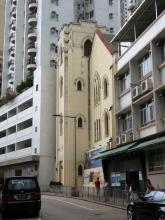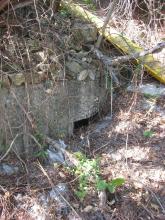Pioneer Memorial Church of Seventh-day Adventists [1939-c.2019]
Primary tabs
Henry Ching remembers going to school here in 1939:
Wrt brianwindsoredgar’s post on the American missionary Charles Winter and the references therein to the schools run by the Seventh Day Adventist, the SDA also ran a small school in their Church in Ventris Road, Happy Valley. I was a “pupil” there, beginning I think in 1939 when I was six years old and until December 1941.
The entire school operated in the hall behind the Church in the American style – i.e. all classes sat together in several rows of desks in the same hall according to grades. I cannot now recall how the teachers managed to teach the different grades all at the same time (I think there were in total about 30 or 40 boys and girls of different ages, the oldest being I suppose about 15), but I don’t think there were more than two or three teachers.
The teachers were all American missionary ladies, and lived in a large house situated on Stubbs Road where the Adventist Hospital now stands.
Based on the following notes from the AAB, Henry must have been one of the earliest pupils at the school:
Historic Building Appraisal
Pioneer Memorial Church of Seventh-day Adventists, No. 17A Ventris Road, Happy Valley, Hong Kong
Historical Interest
The construction of Pioneer Memorial Church of Seventh-day Adventists (基督復臨安息日會先導紀念堂) commenced in May 1938 and was completed in 1939. After that, it became the headquarters of the work of the South China Union Mission of Seventh-Day Adventists (基督復臨安息日會華安聯合會, hereafter “the Mission”). The foundation stone was laid on 27 October 1938 “to the glory of God and in memory of the Pioneers” (榮歸真神 紀念先導).
In 1936, the Mission carried out a campaign to raise funds among members for the erection of Pioneer Memorial Church (its first church in Hong Kong). Mr Larsen of the Mission had called on several occasions and discussed with the Superintendent of Crown Lands and Surveys the question of a site on which to build the Church and suggested various areas. Eventually, in 1937 the Mission acquired by auction the current site in Ventris Road which required cutting away, levelling and retaining wall preparatory to building.
The Church building was designed by Arthur Robert Fenton Raven, Esq. (an authorized architect in private practice) and built by Lam Woo & Co. (聯益公司). Established in 1895, Lam Woo & Co. was founded by Lam Woo (林護) who, together with Huang Mou-lin (黃茂林), Li Wei-zhen (李維楨) and the Rev. A.D. Stewart (史超域牧師) was instrumental to the setting up of St. Paul’s Church at Glenealy in 1911. Notable projects among the many completed by Lam Woo & Co. included St. Paul’s Church (aforesaid) and Fung Ping Shan Building at HKU, built in 1932, which remain standing today.
The local history of Pioneer Memorial Church of Seventh-day Adventists goes back to 1888 when Abram La Rue (亞伯蘭.拉路), First Adventist Missionary in Asia, arrived in Hong Kong to preach the Gospel. Initially, missionary work was mainly done on Hong Kong Island and gatherings were carried out in a rented place in Ice Street, Central. Later on, they commenced religious gatherings in Kowloon and the New Territories such as Shanghai Street (Yau Ma Tei), Hung Shui Kiu (Yuen Long) and Tai Po.
During World War II, the Church was used by the Japanese as a horse stable. After the War, Church services resumed and expanded to Shau Kei Wan, Siu Sai Wan, North Point, Sha Tin and Cheung Chau. The missionaries believe in advancing the philosophy of the Seventh-Day Adventists by educational development and medical care, and runs the Hong Kong Sam Yuk Secondary School (香港三育中學) next door as well as the Hong Kong Adventist Hospital (港安醫院).
Architectural Merit
The architectural style of the Church may be described as Pseudo-Gothic, the distinguishing features being pointed windows with simple flowing tracery, coloured glazing, hood mouldings and buttresses. The three-storey Church has a pitched roof with gabled ends and is built on an east-west axis with a four-storey staircase tower on the north-west corner. The elevations are rendered or stuccoed and painted, except for the lower part of the front elevation facing Ventris Road which has been faced up with granite walling and painted.
The tower is square in plan with buttressed corners, a flat roof and battlemented parapet. Although the windows of the tower are pointed, the main entrance is rectangular in shape with wooden moulded and panelled double doors, and a fanlight of wooden tracery and coloured glazing. The doorway is flanked by lancet shaped panels with inscriptions in Chinese and has two inscribed and moulded name tablets above. Three wide granite steps lead up to the entrance from pavement level.
The top floor is used for worshipping. The nave has a centre aisle and seats arranged on each side for the congregation to sit during services. The chancel and sanctuary are situated at the east end separated from the nave by wide pointed arches. The roof construction is exposed and is particularly interesting featuring unusual hybrid scissor-trusses with braces and collars crossing and fixed to each other. The spaces between the truss components are filled with carved tracery in open trefoil and quatrefoil patterns. The walls are plain and painted white with rows of pointed windows and wall-mounted air-conditioners fitted at high level. Modern light fittings are suspended from the roof.
Rarity, Built Heritage Value & Authenticity
The front façade and elevations appear to have been little altered and therefore remains largely authentic. As mentioned above, the roof construction is very unusual and rarely found in Hong Kong.
Social Value & Local Interest
In addition to its religious role, the Mission has played an important role in educational development in Hong Kong, and therefore has social value and local interest.
Group Value
Other religious buildings and school of historical value in the area include, for example, St. Margaret’s Church at Broadwood Road, St. Paul’s Primary Catholic School in Wong Nai Chung Road, and Tam Kung Temple in Blue Pool Road. Abram La Rue was buried in Hong Kong Cemetery, facing Pioneer Memorial Church in the distance.
Adaptive Re-use
The problem of adaptive re-use does not arise at present.





Comments
Has this been demolished?
Has this been demolished? https://www.hkmapservice.gov.hk/OneStopSystem/map-search# shows the area without any building outlines, just a note "WIP Mar 2019".
Pioneer Memorial Church of Seventh-day Adventists, No. 17A Ventr
The church was demolished and there will be a new development on the site. Meanwhile , the foundation work for the new developmet was under construction.
Just to update the development progress on this site . The new building will be a hostel for the retire people . The construcion sitill in the lower ground stage . I guess it may take another 12 months for teh construction to be completed . I lived in this area and walk by this site almost every week.
Francis Chow 19-Nov-2021
Thanks for the extra info. I
Thanks for the extra info. I've updated the page to show the building has been demolished.
I found an SCMP article from 2014 that says some parts of the old church building will be retained, but we'll have to wait to see how that turns out in practice:
In its application, Pioneer Memorial Church agreed to "preserve the prominent architectural features" when demolishing the historic building and to "incorporate the salvaged items into the newly developed church building".